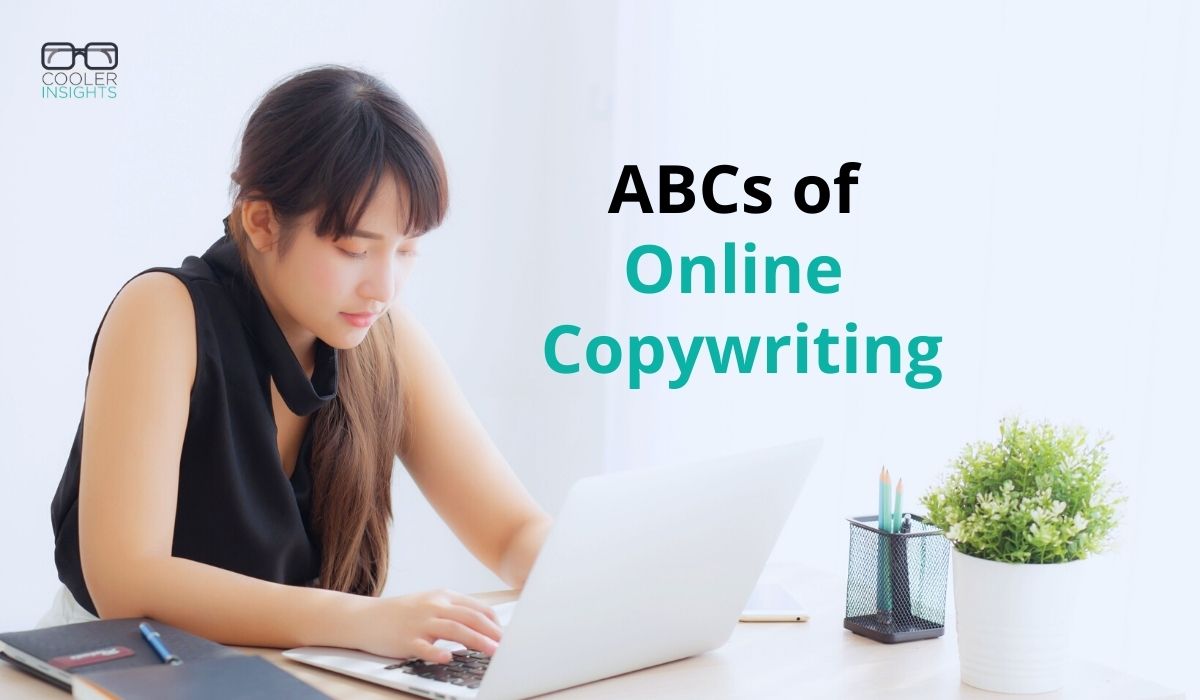
Need help to master online copywriting for your website, social media accounts, SEO pages, emails, and advertisements? You’ve come to the right place!
Two of the greatest digital marketing challenges in Singapore are these:
- How do you write persuasive, sales-generating online copy?
- Where can you hire a competent copywriter/ copywriting agency in Singapore to do the job?
Virtually every platform, channel and format in digital marketing requires copy—from Google Ads (search and display), Facebook Ads, Tweets, Instagram posts and stories, to landing pages, long-form blog articles, emails, and infographics.
Even videos and podcasts need good copy to stand out in your news feeds or Search Engine Results Pages (SERPs). Paired with an appropriate image or thumbnail, compelling copy moves potential viewers and listeners to click, consume and convert.
In this article, I’ll cover what online copywriting is all about, highlight the different forms of online copywriting, warn you about the common mistakes made, and provide a checklist to help you hire the right copywriter for your business.
What is Online Copywriting?

If copywriting is the process of writing the text in advertisements, brochures, sales letters, and promotional materials, online copywriting can be defined as follows:
Online Copywriting: The art and science of writing text for online marketing materials like websites, landing pages, marketing emails, social media posts, online videos, tweets, instant messages, and other channels.
As you’d imagine, copywriting on digital media comes in many styles, shapes and sizes. Each platform and channel have its own unique quirks—what may work well on Facebook may not work well on LinkedIn, for example.
Often the form, structure and tone of voice needed for different online channels differs, depending on who you’re talking to. However, I often find that the best forms of online copy tend to be conversational in nature.
This brings us to the next question.
Who Should You Write For? (Target Audience)

First and perhaps most importantly, you need to identify your target audience.
In the world of digital marketing, your customer profiles (or customer avatars) can be described in the following manner:
- Demographics: What are their age, location, family status, professions/ jobs, education levels, ethnic groups, and other related characteristics like?
- Psychographics: What are their attitudes, beliefs, interests and lifestyles like?
- Buying Patterns: How often do they purchase a product/service like yours? What are their typical basket value of purchases like?
- Pain Points/ Pleasure Points: How can you position yourself as a solution to their problems or desires?
- Online Behaviours: Which online channels do they use? How do you determine which keywords or topics they’re interested in?
Identifying who your target readers, viewers or listeners are is a vital first step in crafting persuasive and compelling online copy.
What are the Different Types of Online Copy?

Background vector created by rawpixel.com – www.freepik.com
This is going to be a long list (and it probably doesn’t cover everything), considering how many platforms, channels and content formats there are online.
Online Advertising Copy
Also known as Pay Per Click (PPC) ads, online ads have been around for a long time. As consumers shift more of their attention to their screens, companies find it imperative to invest a larger fraction of their marketing budget to online advertising channels.
- Search Engine Ads: Google Ads are really the domain of data-crunching nerds and geeks. While there is still some creativity involved in using the right keyword phrases and arrangements, chances are that they’re more often informed by research (eg competitiveness of keywords vs volume of searches vs relevance of search phrase for conversion).
- Banner Ads/ Display Ads: These have a modicum of creativity, and come with different shapes, orientations and dimensions. The trick is to use the least amount of words to trigger the most amount of action.
- Native Ads: Akin to the traditional ‘advertorials’ that you see on newspapers or magazines, native ads can be sponsored articles or feeds on major media websites provided by Taboola or Outbrain. Most native ads feel more like editorial content than ad copy.
- Social Media Ads: Considered to be a form of native advertising, social ads normally look indistinguishable from organic posts, except for the words ‘sponsored’ or ‘promoted’ which identifies the post as an ad. Read more about social media copywriting below.
Oh yes, beyond the usual ads that you place on any online platform, you need to also consider the effect of remarketing/ retargeting ads and what copy should go into them. These normally have a gentle reminder message (eg “Have you forgotten to book your tickets to Bangkok? Get great flight deals here!”)
Social Media Copy
Ah… social networks. These are the channels where your post or ad copy shouldn’t read like they’re copy written.
Wait, what? Yes, you read me right.
The secret to getting people to consume your content (and take action) on social networks like Facebook, LinkedIn, Twitter and others?
Make your post look and sound more like content, and less like a sales pitch.
Here are some other points to take note of…
- Facebook: Keep your prose casual, friendly and laidback; more informal and light banter rather than heavy-going. Soft-sell works better than hard-sell here.
- LinkedIn: To match the expectations of fellow professionals, you should keep your tone polished and professional. Being friendly works, but keep away from using colloquial terms or local slang.
- Twitter: It’s all hell breaks loose here… Or not. The trick here is to keep to 280 characters (or less), and use images, videos and appropriate #hashtags to embellish your copy.
- Instagram: As a visual first channel, your written content should match your photos or videos. Keep it mostly short, use the right #hashtags, and employ ❤ emojis to catch your audience’s attention.
- Pinterest: OK, there isn’t very much space for verbose textual expressions here. Like Twitter, keep your copy short and use it as a teaser to get users to click on the link in your pin.
- YouTube: As the second largest search engine after Google, YouTube content is driven by partially by SEO keyword optimization. This means that you need to craft your video titles, descriptions and links with the right keywords, and use the right file names too.
- SnapChat, TikTok and Instagram Stories: The types of copy on these platforms are probably highly casual and should sound spontaneous in nature. Use stickers, filters, ✨ emojis, hashtags, tags and polls to gamify your content.
Visual Content Copy
In a screen-first world, your photos, videos and graphics can make a world of difference in how potential customers perceive you.
While a picture can paint a thousand words, it is the text accompanying the visuals which can make or break your campaign.
- Infographics: Plan your content categories and sketch out the different steps BEFORE you do any design. If your infographics contains 3rd party research, ensure that you include a link to the source. Use the least amount of words in your copy, but ensure that they include your targeted keywords.
- Text Overlays on Images: Use this space wisely and keep your words to a minimum. Remember that the bulk of copy should be on the post itself.
- Quotes: These are still popular although they work better for some social networks (eg Instagram and LinkedIn) as opposed to others (eg Facebook).
- Call To Action (CTA) buttons: Made to ‘pop out’ in a bright colour, CTA buttons need to be crafted using active (“Get Your FREE copy here”) as opposed to a passive (“Submit Your Request here”) phrase.
- Video Subtitles: These are musts as most viewers on their mobiles watch videos with the sound off so that they do not disturb others around them.
- Video Thumbnails: Don’t miss out on including a word (or three) on your video thumbnails. Learn from Nas Daily!
- Video Descriptions: Here’s a tip—include not only search keywords in your video descriptions but promote your online channels such as your website, social media accounts, and email contacts.
- Video Scripts/ Storyboards: No you’re not a YouTube influencer (at least not yet), and hence, it makes sense for you to write down what you wish to say before rolling the cameras. If your videos are longer, consider putting them together as a storyboard complete with suggested camera angles, visual treatments, and sound effects/ music.
Website and Landing Page Copy
Any form of web copywriting cannot be divorced from Search Engine Optimization (SEO)—the art and science of enhancing your website and its pages so that they can be ranked for specific keywords on search engines.
(I’ve written an entire piece of SEO-led content; read it for good measure.)
- Home Page: The most important piece of your online real estate, your home page should be written in such a way that it markets your business in the most favourable manner. Include your accolades, awards and testimonials here.
- About Us Page: Use this page to narrate your brand story, and to build trust, respect and affection from your prospects.
- Product/ Service Pages: Avoid using overly flowery ways to describe your product or service. Rather, stick to the conventional keywords or phrases that your target audience would use. And remember to include information that helps to aid the buying decision such as your product dimensions, colours, materials, and any warranties or guarantees.
- Promo/ Lead Pages: If you intend to capture leads through offering an incentive (eg a sample product or free download), it is important to highlight the benefits of what you’re offering. Do also make sure that your CTAs are visible.
- Contact Us Page: Don’t underestimate the importance of this page—often, your prospects would communicate with you through this page. Keep your language friendly and don’t forget to include other useful contact information like your phone number, email addresses or physical address (complete with map).
- Navigational Elements: Remember to use the simplest words to describe your different pages, and incorporate breadcrumbs (navigational) to assist in way-finding on your website.
Email Marketing Copy
As one of the most intimate communication channel, emails must be written with care.
Make sure that you keep the contexts of your emails clearly in mind. Do not ever send emails out of the blue. Always have a specific brand or company related reason to do so.
Keep your copy to 200 words or less, and avoid attaching too many images or videos. Where possible, stick to a single message and value proposition.
Oh, and remember to write like the way you speak—but better.
Here are some of the emails that an email marketer may need to write copy for:
- DRIP Campaign: Popularised by Jeff Walker (see Launch), an email drip campaign is a “triggered sequence of automated emails sent on a predefined schedule to email subscribers to achieve a specific result.” Often, this is a general sequence aimed at bringing subscribers to a deeper relationship with your company.
- Lead Nurturing Sequence: These are customised to different audience segments or groups, according to their interactions with your content at different touch-points. Your goal is to craft copy that slowly nurtures them along your marketing funnel.
- Direct Response Emails: An offshoot of direct response sales letters in the past, such emails are normally crafted with a compelling offer and CTA at the end. These days, a variation of direct response type copy may be found on lead or promotion pages instead of emails.
Instant Messages/ Direct Message/ Chat Copywriting
Instant Messaging (IM) or chat apps are fairly ubiquitous. The most popular ones include the following:
- Line
- Telegram
- Facebook Messenger
- Direct Messages (DMs) on LinkedIn, Twitter, Instagram and others
The crafting of Instant Messages, Private Messages or Direct Messages can be similar to emails except for one thing:
They must be even shorter, more succinct, and valuable.
Oh, and you need to be even more careful about not sending junk—your subscribers can leave or block you in a jiffy!
As recipients (whether one-to-one, broadcast or in a group) may respond immediately upon receipt of the message, you need to be on your toes. Slow responses are the death knell of IM or chat apps.
Do also use emojis ✅ to ensure that your message pops out ? and catches their attention.
10 Common Mistakes in Online Copywriting

Woman photo created by tirachardz – www.freepik.com
In all my years of working with hundreds of brands (either as an agency or trainer), I often find the following copywriting mistakes made by companies.
#1 Lack of Social Proof
Don’t assume that your prospect knows all about your 20 years in business, or your immaculate track record. Include any evidence which demonstrates your business prowess:
- Numbers of customer served
- Value of sales made
- Big name clients
- Awards and accolades
- Media mentions
#2 Not Providing Enough Value
In a world full of snake-oil salesmen, the brand that wins the customer is the one that offers real help (not hype). What Jay Baer would call Youtility.
Instead of putting exclamation marks behind every sentence, use your online space to offer helpful tips, templates and checklists that your clients can use.
#3 Insufficient Brand Storytelling
The “About Us” section of your website is a veritable gold mine for prospects. Sadly, most companies do not put enough effort in narrating their brand story—information such as their history, founders, company milestones, and key discoveries.
Ignoring this page is literally leaving money on the table!
#4 Too Sales-focused
Nobody likes to visit a website that reads like a glorified brochure. While it is fine to extol your brand benefits now and then, you need to go beyond making every section of your website a promotion, package or hot deal.
#5 Too Few Visual Content
The best written copy in the world will not save a website with crappy (or insufficient) photos and videos. These are necessary not only as natural eye breaks, but also to better illustrate a point to your audience.
#6 Too Little Copy
On the flip side, there are companies that write too little. It is pointless to have an entire gallery of images if none of them have any captions.
Length of content is also important from an SEO perspective. Thin content pages tend to rank poorly on search engines.
#7 Poorly Placed Calls To Action (CTA)
Some websites are inundated with countless CTAs. Others have so few CTAs that you’re left wondering what you should do next.
The best number is about 2 to 3 CTAs per page.
#8 Excessive Use of Jargons
Putting technical mumbo-jumbo in your website doesn’t show that you are clever. On the contrary, it may lead your audience to scratch their heads, wondering what you’re trying to communicate to them.
Use the acronym KISS—Keep It Simple and Stupid!
#9 Copy not In Sync with Images
Do you know what is cognitive dissonance? It is the feeling that you get when you have to reconcile two conflicting pieces of information. This happens when your online copy does not gel with your images.
To prevent this, ensure that what you show and what you tell are coherent and connected.
#10 Poor Command of English
Finally, badly written web copy can pull down your online marketing efforts.
This covers everything from spelling and grammatical mistakes to the wrong use of tenses, punctuation marks, and sentence structures.
Should You Outsource Online Copywriting?

This is the million (or hundred thousand) dollar question:
Should we try to write all online copy ourselves? Or should I work with an online copywriting or content marketing agency (like Cooler Insights)?
The answer really depends on four things:
- Your existing bandwidth
- Your team’s ability to craft effective online copy
- Your available marketing budget
- Your expectations for online copywriting
If you’re thinking of outsourcing your online copy, do consider the advantages and disadvantages of doing so…
Pros of Outsourcing Copywriting
Naturally, there are benefits to working with a content marketing or online copywriting agency.
Doing so allows you to focus on what you do best—your core areas of business—and allow professional content creators to do theirs.
You can also glean the years of experience and knowledge which the agency has, above and beyond what you’re familiar with in the industry.
Outsourcing can also supplement your limited manpower resources, especially when you find it difficult to hire writing talents.
Oh, and one more thing.
Working with an external party helps you to tap the best practices which the agency has amassed. This significantly reduces your learning curve.
Cons of Outsourcing Copywriting
Having said that, there are also drawbacks to working with an agency.
Good online copywriters aren’t cheap. The per piece rate for online content may be more costly than doing it inhouse.
The outsourced agency may also not know how your trade or business operates. This could result in blind-spots.
Sometimes, outsourcing copywriting may also result in a “hollowing out” of digital marketing talent in a company. Over time, such dependence could reduce your core sets of digital marketing capabilities.
Hiring the Right Online Copywriting Agency in Singapore

OK, you’ve carefully considered the pros and cons and decided to engage a copywriting or content marketing agency.
What should you look out for when you hire an online copywriting agency in Singapore?
Use this checklist to guide you:
#1 Relevant B2C or B2B Experience
Does your agency have experience in your specific industry? If not, are there close proxies that you can use to compare them with?
#2 Profile of Content Writers
Are the writers fresh hires or experienced veterans? Have they worked with big brands before? Are they adequately trained in journalism, public relations, and SEO-led copywriting?
#3 Track Record and Client List
Who are the clients of the agency? Do they represent the type of companies that yours could fit in easily?
(Note that having a lot of huge MNC clients needn’t necessarily be a good thing—such agencies normally cost an arm and a leg!)
#4 Knowledge of Digital Marketing Principles
Is the agency knowledgeable about online customer journeys and digital marketing funnels? Do they know how to build landing pages that convert visitors to leads and customers?
#5 Knowledge of SEO-led Content
Does the agency talk about SEO when they talk about online content? Are they aware of the relationship between content marketing and SEO? Do you see evidence of their work in this area?
#6 Knowledge of Social Media
Does the agency know enough about the different social networks—Facebook, Instagram, LinkedIn, Twitter, Pinterest, YouTube? Are their leaders active on social media? Would they be plugged into the constant algorithmic changes in these platforms?
#7 Evidence of Innovation/ Experimentation
Is there evidence that the agency is willing to experiment and test new approaches to copywriting? Have they piloted or pioneered novel online marketing content for their clients (and achieved results)?
#8 Data-driven and Analytics Savvy
Do the staff of the agency know how to measure the performance of their content writing efforts? Can they help you to track, monitor and optimize your marketing ROI across the entire funnel, using different forms of content?
#9 Right Chemistry
Perhaps most importantly, do you feel comfortable working with the agency? Do they give you the right vibes in meetings and briefings? Are they transparent about their strengths and their weaknesses?
Conclusion
Managing your online content isn’t easy. While there are numerous factors which determine the success (or failure) of your digital marketing efforts, neglecting to write the right copy can be costly.
Hopefully, this comprehensive guide will help you to shortcut your learning curve, and point you in the right direction when it comes to online copywriting.
Need Help with Your Online Copywriting?
Wish to have an extra pair of hands (or three) to help you to craft compelling, engaging and effective content for your digital marketing channels? Drop us an enquiry using the form below and we can arrange for a free 30-minute consultation.
